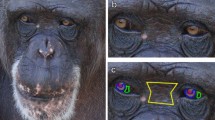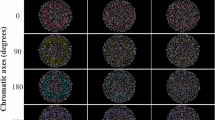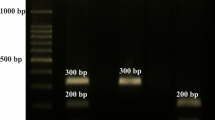Abstract
Old World primates have trichromatic vision because they have three types of cone photoreceptor, each of which is maximally sensitive to short, middle or long wavelengths of light1. Although a proportion of human males (about 8% of caucasians, for example) have X-chromosome-linked colour-vision abnormalities2, no non-human Old World primates have been found to be colour-vision defective3,4. We have tested 3,153 macaque monkeys but found only three dichromats, a frequency that is much lower than in humans.
This is a preview of subscription content, access via your institution
Access options
Subscribe to this journal
Receive 51 print issues and online access
$199.00 per year
only $3.90 per issue
Buy this article
- Purchase on Springer Link
- Instant access to full article PDF
Prices may be subject to local taxes which are calculated during checkout


Similar content being viewed by others
References
Tovée, M. J. Trends Neurosci. 17, 30–37 (1994).
Fletcher, R. & Voke, J. Defective Colour Vision: Fundamentals, Diagnosis and Management (Hilger, Bristol, 1985).
Jacobs, G. H. & Harwerth, R. S. Am. J. Primatol. 18, 35–44 (1989).
Jacobs, G. H. & Deegan, J. F. Vis. Neurosci. 14, 921–928 (1997).
Nathans, J., Thomas, D. & Hogness, D. S. Science 232, 193–202 (1986).
Vollrath, D., Nathans, J. & Davis, R. W. Science 240, 1669–1672 (1988).
Deeb, S. S. et al. Am. J. Hum. Genet. 51, 687–700 (1992).
Dulai, K. S. et al. Vision Res. 34, 2483–2491 (1994).
Merbs, S. L. & Nathans, J. Science 258, 464–466 (1992).
Neitz, J., Neitz, M. & Kainz, P. N. Science 274, 801–804 (1996).
Drummond-Borg, N., Deeb, S. S. & Motulsky, A. G. Proc. Natl Acad. Sci. USA 86, 983–987 (1989).
Jorgense, A. L., Deeb, S. S. & Motulsky, A. G. Proc. Natl Acad. Sci. USA 87, 6512–6516 (1990).
Kojima, D. et al. Biochemistry 35, 2625–2629 (1996).
Bowmaker, J. K., Dartnall, H. J. & Mollon, J. D. J. Physiol. (Lond.) 298, 131–148 (1980).
Author information
Authors and Affiliations
Corresponding author
Rights and permissions
About this article
Cite this article
Onishi, A., Koike, S., Ida, M. et al. Dichromatism in macaque monkeys. Nature 402, 139–140 (1999). https://doi.org/10.1038/45966
Issue Date:
DOI: https://doi.org/10.1038/45966
This article is cited by
-
Paradoxical impact of memory on color appearance of faces
Nature Communications (2019)
-
Opn5L1 is a retinal receptor that behaves as a reverse and self-regenerating photoreceptor
Nature Communications (2018)
-
Color vision diversity and significance in primates inferred from genetic and field studies
Genes & Genomics (2016)
-
Sphere-formation culture of testicular germ cells in the common marmoset, a small New World monkey
Primates (2016)
Comments
By submitting a comment you agree to abide by our Terms and Community Guidelines. If you find something abusive or that does not comply with our terms or guidelines please flag it as inappropriate.



